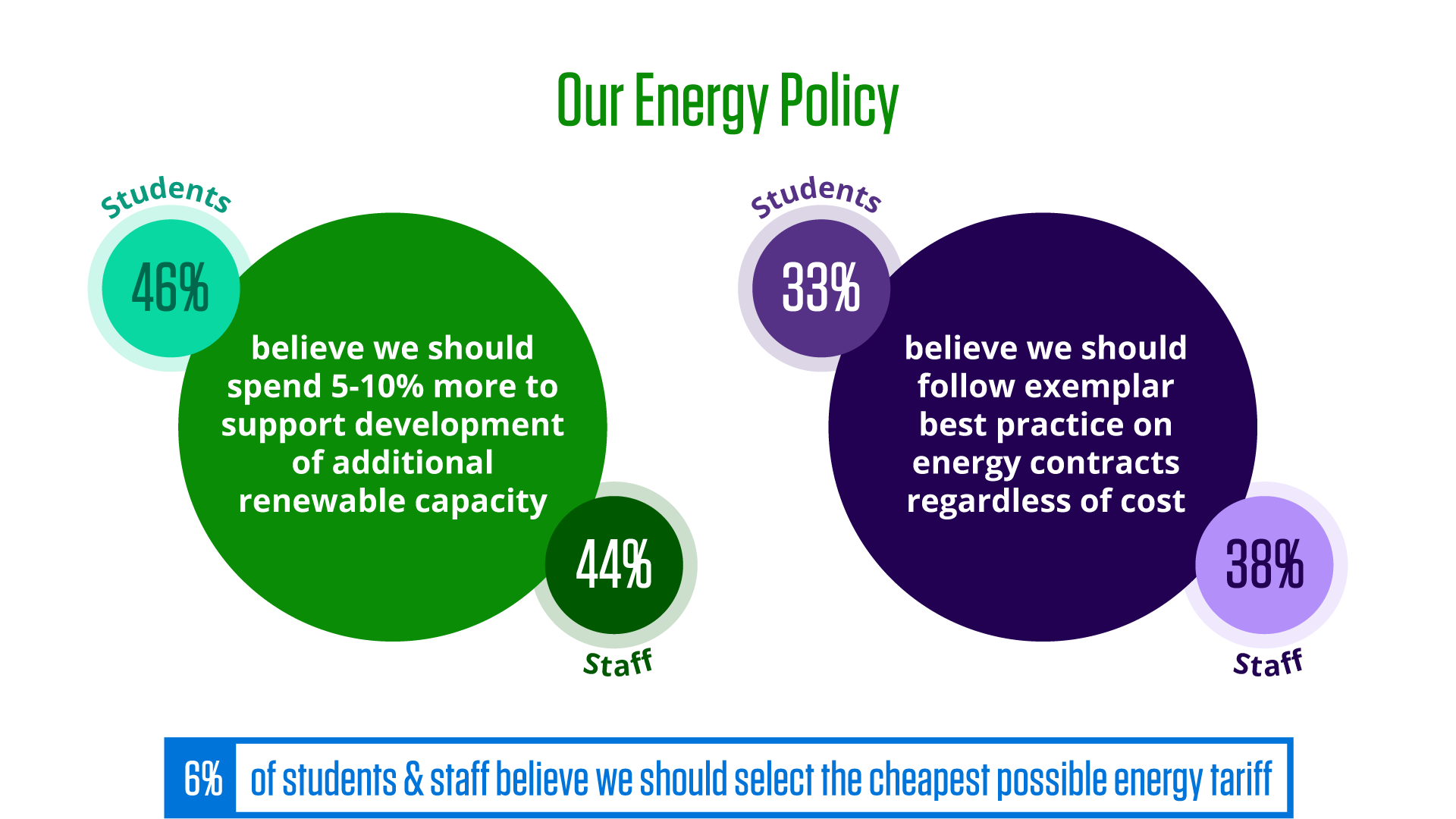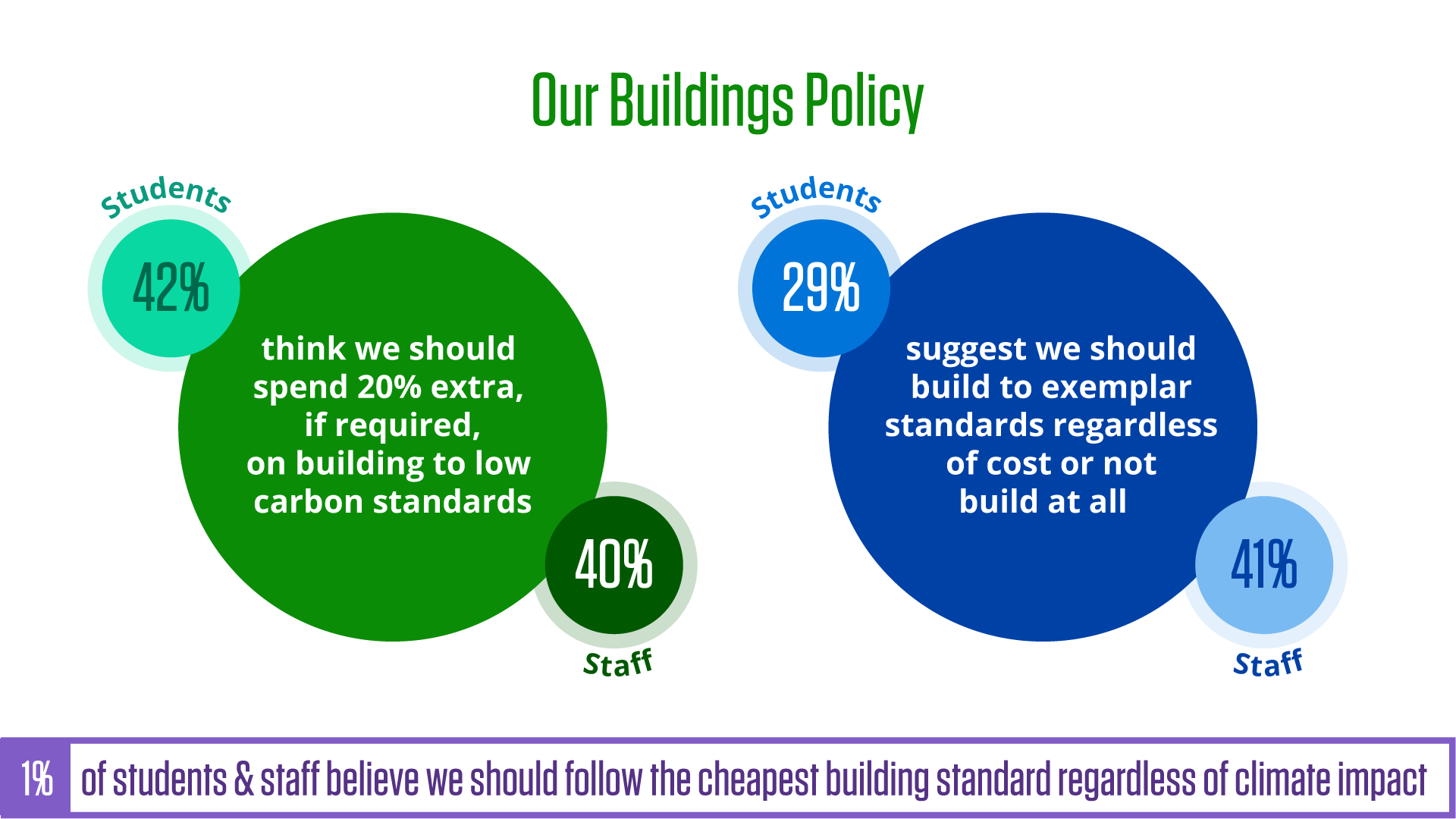Climate Action Survey 2021 results: staff and students have their say on the University’s journey towards carbon neutrality
University students and staff have shown their enthusiastic support for investing more in high-quality buildings with low carbon standards. Fewer than 1% of respondents believe the University should follow the cheapest building standard, with 42% of students and 40% of staff stating that they think the institution should spend 20% extra on building to low-carbon standards.
Addressing our existing buildings is also clearly key to reducing our carbon emissions and achieving net zero. As well as mitigating our impact we also need to adapt - climate change is already here and set to significantly affect the performance of the University’s current building stock. Therefore, considerations must be made regarding how numerous buildings on-site will be affected – and what we can do to ensure greater day-to-day efficiency of those buildings.
Setting an example for energy efficiency
The University is committed to reaching net-zero carbon in its Scope 1 and 2 emissions by 2030.
The survey results showed that the majority of our community is open to changing their own personal behaviour in order to save energy. Changes included switching off lights, appliances and devices when not in use and avoiding taking a lift. They could also include behaviours around specialist equipment such as closing fume cupboard sashes (did you know a fume cupboard can use the same energy as 3 houses!).
Energy Use
Over 30% of respondents think the University should 'set an example' when it comes to its energy use, stating that we should adopt best practice standards irrespective of upfront costs.

Decarbonisation of the UK electricity grid
The UK’s National Electricity Grid is decarbonising rapidly, and this is expected to continue as increased low carbon generation is used (think of all those wind farms in the North Sea). This decarbonisation switches the carbon spotlight onto gas use instead of electricity, and hence the focus is now on the electrification of heat and the use of heat pumps (for houses and non-domestic buildings). The future will likely involve the end of the combustion of fossil fuels as the main source of heating. While this can deliver a considerable reduction in carbon emissions, it is not without its issues for all of us in our houses as well as the University, including:
- Electricity is currently more expensive than gas, bringing cost implications
- Electrification of heating through the use of heat pumps is not always simple, especially in existing buildings and will require investment in the heating systems and insulation to enable the change of heating source
Although electricity is decarbonising, the University still needs to reduce consumption – this will still save some carbon, and lots of money.
What should we do to reduce our energy footprint?

Reduce energy use in buildings
As the University continues the ongoing process of improving our campus, it will need to consider how it approaches embedding net-zero in refurbishment and construction of new buildings. One approach to constructing high-efficiency buildings that is gaining momentum is the Passivhaus methodology, which includes a retrofit standard, EnerPHit for refurbishments. PassivHaus is a market-leading standard for ultra-low energy design, that brings additional benefits including rigorous standards to ensure build quality and true return on investment. It follows a ‘fabric first’ approach – i.e. insulate and minimise leaks before anything else.
Comparing the cost of building to Passivhaus standards and traditional build is not straight forward as it is not comparing like for like – a Passivhaus or low carbon project will make different design decisions upfront. Research suggests that any extra cost of achieving Passivhaus is falling over time as aspects of its approach become more mainstream. Recent analysis has showed that by following some key principles and leveraging prior experience, Passivhaus projects in the UK are likely to be achieved for a modest extra over cost of around 4% or less. This is well within the 20% uplift that over 40% of respondents in our survey are supportive of spending to achieve low carbon buildings.
Use energy efficiently
We should always strive to follow the correct ‘energy hierarchy:

Image: Energy hierarchy, Phillip Wolfe
Over the last decade, much work has been done on this already, and we have reduced our energy consumption despite growing the campus by around 40%.
We now need to continue to:
- reduce energy lost through our networks, our systems, and our buildings
- use building management systems to fine-tune our building services
- install efficient equipment, both as part of our buildings (lighting, ventilation, boilers, pumps, fans etc) and within our buildings (IT equipment, lab equipment, etc)
- encourage behaviour change to support energy efficiency (see Student Switch Off and Leaf )
Develop low carbon and renewable sources of energy
Meeting our carbon targets requires major reductions in the energy demands of our campus and buildings, supported by the provision of energy from renewable sources.
To understand how the former can be achieved, we have commissioned a heat decarbonisation study of our campus. This will look at how we can ensure that future investment in the campus supports the transition to a low carbon campus.
On renewables we hope to significantly increase our solar panel capacity from the 5 large rooftop systems we have now but note that this will only ever generate a small proportion of our overall use.
Keith Zimmerman, Chief Operating Officer:
"It is widely recognised that minimising carbon emissions is essential, but also a real challenge. Addressing the environmental issues related to buildings are no exception.
Our Estate at the University of Bath has invested in some big capital projects recently, but we now need to turn our attention to improving our existing buildings. We want to embrace the opportunities which the pandemic has opened up to us, to use our space more efficiently, and to avoid the cost, both financial and environmental, of creating new buildings. This will be one of the key priorities for our Estates team and our new Director , who will be starting at the University in the autumn of this year.
We plan to use these opportunities together with continuing investment to make our estate truly energy efficient and low carbon, as well as being cheaper to run, nicer to work in and more attractive for all of us!
I know you will want to join me in doing all we can to address this overarching imperative for our planet and (writing as a brand new grandfather) generations to come."
Carbon neutral buildings: From design to creation
To achieve the University’s future energy performance targets for buildings, a carbon-neutral design is key. We are committed to developing low carbon buildings and have set ourselves ambitious targets to lower our footprint.
What is the carbon footprint of a building?
Buildings and their construction account for significant energy use both globally, and on our campus. Building emissions are a combination of two things. First is the amount of carbon generated through manufacturing building materials, transporting materials to construction sites and the actual construction process – the 'embodied carbon’ of a building, which can account for 40-70% of a building’s total lifecycle carbon emissions. Second is day-to-day energy use – known as the 'operational carbon emissions' that come from powering lighting, heating and cooling etc.
When assessing the University’s need for new buildings, or alterations to existing ones, sustainability should be considered throughout all stages of building development, from design to post-occupancy, to end of life.
This includes:
- minimising the embodied carbon of all materials used
- minimising the quantities of materials used
- using recycled materials when possible
- minimising transportation during construction
- low energy and water consumption
- how a building will be maintained, refurbished and then dismantled at the end of its life
What is a net-zero building?
With one of the highest ranked built environment (architecture and civil engineering) departments in the UK, the University has a unique opportunity to put into practice what it teaches about the case for net-zero buildings. In 2019/20, operational carbon emissions from our campus buildings contributed 12% to our overall carbon footprint, with the embodied emissions in new buildings contributing 18%.
Of course, the truest net zero building is the one that doesn’t get built. We should always question the need for a new building and look to instead refurbish an existing building as priority. Efficient management of existing building space is an essential first step. Where a new building is needed then the same hierarchy as above should be used to minimise both the embodied and operational carbon, before thinking about renewables or offsetting – see Net-Zero-Carbon-Buildings-A-framework-definition.pdf (ukgbc.org)
In order to achieve net-zero on our campus, we must make informed decisions about building refurbishment and design in the very early stages of planning in order to lock in carbon and energy requirements for the future.
Tim Ibell, Dean, Faculty of Engineering and Design:
“The road to net zero across most industries, in priority ordering, is firstly to use less stuff and less energy, secondly to re-use stuff and use low-carbon materials, and finally (in order to just get us over the line) to offset.
Often, the priority ordering above is reversed, and particularly when dealing with the built environment. We know how to design net-zero buildings, when needed, and we should use these skills.”
Smart and sustainable campus
As an innovative University, we are committed to driving change and transforming our campus into a carbon-neutral institution. We can also use this exercise for research and for educational purposes. By educating future experts across all societal fields, we are also well-placed to be proactive in reducing emissions to reduce the impacts of climate change.
Climate change affects us all. To stay up-to-date on the latest action taken by the University to lower its footprint, visit our climate change hub.
Notes about the survey
-
This survey was conducted in November 2021.
-
This survey was completed by 3985 respondents, representing 39% of University staff and 11% of students.
-
This survey was commissioned by the Climate Action team with methodology devised and results analysed by Dr Paul Haggar, Prof Lorraine Whitmarsh, Kaloyan Mitev and Hannah Lester.
-
The collated survey data can be accessed by members of the University of Bath community here.
-
If you have any questions about the nature of this survey, please contact climateaction@bath.ac.uk
Respond
